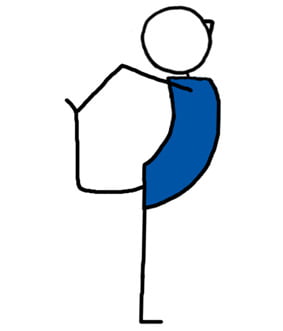
Standing Head To Knee A
| Sanskrit Name: | Dandayamana Janushirasana |
|---|---|
| Similar Pose Names: | Standing head to big toe a, big toe hold a, standing big toe a,Standing knee to chest |
| Category: | Standing |
| Share on: |
 Yoga Lesson Planner
Yoga Lesson Planner
 Pilates Lesson Planner
Pilates Lesson Planner
| Category: | Yoga Lesson Planner |
|---|---|
| Sub Category: | Standing |
| Types: | Balance, Forward Bend, Hip Opener, Standing, Strengthen, Stretch |
| Anatomy: | Arms & Shoulders, Biceps & Triceps, Core, Hamstrings, Hips, Lower Back, Middle Back, Psoas, Wrists & Arms |
| Chakras: | Base, Sacral Centre, Solar Plexus Centre |
| Therapy: | Leg Congestion, Poor Posture, Varicose Veins |
| Drishti: | Tip Of Nose |
| Dosha: | Kapha, Pitta, Vata |
| Meridian Lines: | Stomach |
Stand with feet together. Toes and heels touch. Shift body weight to left leg. Interlace fingers and thumbs (forming a cup with hands). Contract abs, bend at waist, pick up right foot with palms cupping the sole around balls of feet (If you struggle to reach foot, bring right knee up and grab just underneath knee cap using the same grip). Look forward. Keep left leg locked contracting quads, hams, glutes and abs to keep balance. Hold. Return to standing. Switch legs. This is starting position for Standing Head To Knee pose. If you can't lock the standing leg, stay in this stage of the pose until you can.
Strengthens thighs, buttocks, hamstrings, ankles. Increases mental strength.
A) Strap looped around sole of foot instead of hooking big toe with fingers and thumb. B) Raised leg on back of chair. C) Use a wall as a prop (to stay in the pose for longer). D) Press raised heel firmly into wall. E) Do the pose lying down in Reclined Big Toe pose. F) Fold torso forward toward lifted leg. G) Come into full extended hand to big toe pose.
Knee injury.
Click here for lots of FREE downloadable Yoga lesson plans.
Click here for lots of FREE downloadable Pilates lesson plans.
- Cavendish 5 Nov 19
- Vinyasa 11-6-19
- Conditioning
- intermediate simple, stretch, balance and patience with challenges
- Intermediate Stretch, balance and patience
- intermediate simple, stretch, balance and patience with challenges
- Yama - aparigrahah non grasping
- 8 Dec Starfish Warrior
- Samana vayu week 8
- Online 23 Mar 21
- Ask Genie2
- Online 30 Mar 21
- Week 1
- Ask Genie1
- Hatha Yoga: Finding Balance With Plough As Peak Pose
- Finding Balance 3rd edition
- Hatha Yoga: Finding Balance With Plough As Peak Pose
- Finding Balance
- Ask Genie 1
- Hatha Yoga: Finding Balance With Plough As Peak Pose
- Ask Genie 1
- Kartick 2
- Kartick
- Hatha Yoga: Finding Balance With Plough As Peak Pose
- earth grasshopper 2 45 mins
- Ask Genie 3
- Hatha Yoga: Finding Balance With Plough As Peak Pose
- Ask Genie 2
- Ask Genie 5
- Ask Genie 1
- Ask Genie 6
- Ask Genie 22
- Ask Genie 2
- Ask Genie 1
- Ask Genie 1
- Balance and Stability 3 Equilibrium
- Crow Prep
- Ask Genie 1
- Week 6: Finding Balance With Plough As Peak Pose
- Balance and Stability 3 Equilibrium
- Crow Prep
- Ask Genie 2
- Ask Genie 2
- 2 Sep 2024
- Ask Genie 2
Standing Head To Knee Pose Tips
Tip 1: Work on your balance first with the Tree pose.
Tip 2: Focus on your breath when exiting the pose.
Tip 3: When you feel comfortable, progress to the Standing Head To Knee B pose.
Tip 4: When you feel comfortable, progress to the Standing Head To Knee C pose.
Tip 5: Understand that balance is the ability to control your body’s position, whether stationary (i.e. a complex yoga pose) or while moving (e.g. playing golf). Balance is a key component of Yoga, along with strength and flexibility poses.
Top 5 Benefits Of Balance Poses:
1) Body Awareness – Body awareness is the sense of how your limbs are oriented in space, also known as proprioception. Balance training improves body awareness, which decreases the likelihood of injury.
2) Coordination – Balance poses require your entire body to work in harmony, otherwise, you will fall or stumble. Improved coordination during balance poses will be transferred into coordination in everyday life.
3) Joint Stability – Balance poses promote stable knees, ankles, hips, and shoulders. This can prevent a multitude of injuries including sprained ankles and knee problems.
4) Reaction Time – Balance poses can improve your reaction time. If you happen to slip or stumble when performing balance poses, your body needs to re-balance immediately or you will fall. This in turn will improve your reaction time in everyday life.
5) Long-Term Health – Adding balance poses into your Yoga session helps to maintain or improve your balance, which is needed to prevent falls and fractures. As we age, our balance can deteriorate. Yoga balances will help delay that deterioration.
















